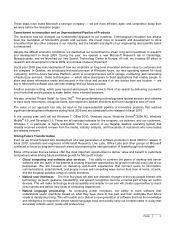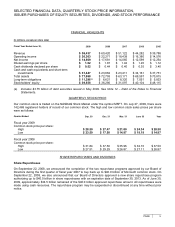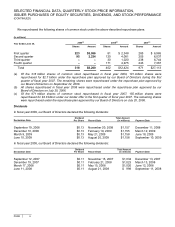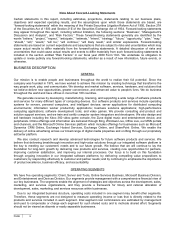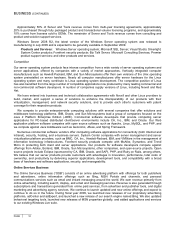Microsoft 2009 Annual Report Download - page 3
Download and view the complete annual report
Please find page 3 of the 2009 Microsoft annual report below. You can navigate through the pages in the report by either clicking on the pages listed below, or by using the keyword search tool below to find specific information within the annual report.
PAGE 3
These steps have made Microsoft a stronger company — we are more efficient, agile, and competitive today than
we were before the recession began.
Commitment to Innovation and an Unprecedented Pipeline of Products
The recession has not changed our fundamental approach to our business. Technological innovation has always
been the foundation of Microsoft’s growth and success. We invest more in research and development to drive
innovation than any other company in our industry, and the breadth and depth of our engineering and scientific talent
is unmatched.
Despite the difficult economic conditions, we maintained our commitment to smart, long-term investment in research
and development in fiscal 2009. During the year, we opened a new Microsoft Research lab in Cambridge,
Massachusetts, and we launched our new Search Technology Center in Europe. All told, we invested $9 billion in
research and development in fiscal 2009, an increase of about 10 percent.
Fiscal year 2009 saw many examples of how our emphasis on long-term innovation delivers value to customers and
the company. In October, we introduced technical previews of Windows Azure, our new operating system for cloud
computing, and the Azure Services Platform, which is a comprehensive set of storage, computing, and networking
infrastructure services. These technologies — which allow developers to build applications that enable people to
store and share information easily and securely in the cloud and access it on any device from any location — are
key to Microsoft’s software plus services strategy and our future success.
Another example is Bing, which goes beyond what people have come to think of as search by delivering a powerful
set of tools that enable people to make faster, more informed decisions.
We also unveiled “Project Natal” for Xbox 360®. This groundbreaking technology uses special sensors and software
to track body movements, recognize faces, and respond to spoken directions and even changes in tone of voice.
The value of our approach can also be seen in the unprecedented pipeline of innovative products that reached
significant development milestones during fiscal 2009 and are scheduled to be released in fiscal 2010.
In the coming year, we’ll roll out Windows 7, Office 2010, Windows Azure, Windows Server® 2008 R2, Windows
Mobile® 6.5, and Silverlight 3.0. These are all important releases for the company, our partners, and our customers.
Windows 7, in particular, is highly anticipated. This new version of our flagship desktop operating system has
already received excellent reviews from the media, industry analysts, and thousands of customers who have tested
pre-release versions.
Driving Future Transformation
Even as we moved forward with development of a new generation of software products in fiscal 2009 for release in
fiscal 2010, scientists and engineers at Microsoft Research, Live Labs, Office Labs and other groups at Microsoft
continued to focus on long-term research aimed at pioneering the next generation of breakthrough technologies.
Some of the areas that we believe offer the most important opportunities to deliver value and benefit to customers
and partners while driving future profitable growth for Microsoft include:
• Cloud computing and software plus services: The ability to combine the power of desktop and server
software with the reach of the Internet is creating important opportunities for growth in almost every one of our
businesses. We are focused on delivering end-to-end experiences that connect users to information,
communications, entertainment, and people in new and compelling ways across their lives at home, at work,
and the broadest-possible range of mobile scenarios.
• Natural user interfaces: The next few years will also see dramatic changes in the way people interact with
technology, as touch, gestures, handwriting, and speech recognition become a normal part of how we control
devices. This will make technology more accessible and simpler to use and will create opportunities to reach
new markets and deliver new kinds of computing experiences.
• Natural language processing: As computing power increases, our ability to build software that
understands users’ intentions based on what they have done in the past and then anticipate their future
needs is rapidly improving. This will enable us to deliver a new generation of software that has the knowledge
and intelligence to respond to simple natural language input and quickly carry out complex tasks in a way that
accurately reflects users’ needs and preferences.



